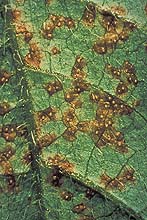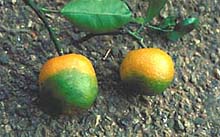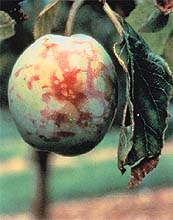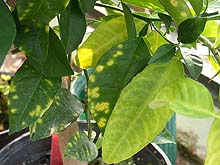|

Dark brown or reddish lesions of soybean rust, a former APHIS select agent, now present in the United States. Courtesy G. L. Hartman. |
This “White Paper” presents a clarification and expansion of positions and recommendations of The American Phytopathological Society (APS) on countering agricultural bioterrorism through “crop biosecurity.”
An earlier white paper was used as a briefing document in March 2002 for staff and officials of the executive and legislative branches, including the USDA, the Office of Homeland Security, House Science Committee, and the House Agriculture Committee. This second white paper identifies an emerging difference between the government and the scientific community on strategies for countering agricultural bioterrorism, as well as some positive developments and continuing unmet needs for increasing crop biosecurity.
The 5000 members of APS include a broad representation of the national and international scientific leadership and expertise for protecting agriculture against crop diseases, regardless of nature of the threat agent and whether it is accidentally or intentionally introduced. APS efforts in response to concerns for crop biosecurity in the United States have been directed simultaneously and coordinately
within the Society, so as to provide a process for information channeling and exchange, including member participation in any response and policy formulation of the Society, and
outside the Society, through interactions and cooperation with government agencies, academic institutions, and private organizations.
The process of information exchange and policy formulation within the Society, and of interactions with various outside groups, were focuses of the annual meeting of APS, held July 27-31, 2002, in Milwaukee, WI. Three sessions (one symposium and two discussion sessions) were held coordinately during three successive afternoons (July 28, 29 and 30). These three sessions moved progressively from a broad look at the many issues and implications of plant pathogens used as agents of bioterrorism, including the continued need for international cooperation and education of foreign students, to a focused discussion on building a distributed laboratory network to facilitate diagnosis, communication, and training.
Finding Balance between Two Strategies: Prevention and Preparedness
The sessions at the 2002 APS annual meeting revealed two fundamentally different strategies for assuring crop biosecurity:
prevention and
preparedness. Prevention is currently focused on increased security, secrecy, and border protection. Preparedness focuses on early detection, rapid diagnosis, and rapid recovery. Both are important, but too much focus on security and secrecy will impair the necessary free and open conduct of science and information exchange fundamental to both prevention and preparedness.
What has become clear is that the laws passed by Congress and now being implemented are focused mainly on prevention, whereas the scientific community has embraced a focus on preparedness, including preparedness as a means of prevention. APS is greatly concerned that increased security as the primary means of prevention and enforced through laws will be counter productive to preparedness. APS endorses the approach of “narrow areas with high walls,” a long-standing position of the scientific community generally and the U.S. National Academy of Sciences specifically on matters of science versus national security.

Mandarin orange (Citrus reticulata Blanco) with symptoms of citrus greening, caused by
Candidatus Liberobacter asiaticum, a former APHIS select agent, now present in the United States. This disease is vectored by the Asian citrus psyllid,
Diaphorina citri. Courtesy Tim R. Gottwald and Steve M. Garnsey.
| |
As example that could place high walls around an unnecessarily broad area of plant pathology research, teaching, and extension is the “select list” developed by the USDA Animal and Plant Health Inspection Service (APHIS) in response to the Public Health Security and Bioterrorism Preparedness and Response Act signed into law on June 12, 2002 (from the Federal Registry, see the
Agricultural Bioterrorism Protection Act of 2002: Listing of Biological Agents and Procedures for Notification, as well as the
Notice of OMB Approval of Data Collection). This law directs APHIS to list those plant pathogens considered as high risk for deliberate use against U.S. crops. When finalized, scientists working on the diseases caused by pathogens on this “select list,” and the agricultural commodity commissions, state agricultural experiment stations, and federal agencies that fund research and extension activities aimed at control of these pathogens, potentially face special and expensive security measures, restrictions on who can do the work, and burdensome reporting mechanisms.
The official U.S. “select list” of plant pathogens for which special security and reporting measures might be required should be short, limited to currently exotic pathogens of U.S. crops, and be subject to periodic review based on scientifically based risk assessment procedures. APS is prepared to voluntarily examine its editorial policies with respect to new information on any one of the pathogens on this list submitted for publication in one of its journals. APS does not support the inclusion on this select list of any strain representative of a pathogen population already in the United States and already under some level of management. This would include foreign or “genetically modified” strains of endemic pathogens. Security walls around endemic and widely distributed plant pathogens would have a chilling and clearly counterproductive effect on the very research and international cooperation needed to limit the crop damage they already cause naturally. However, determination of a broader threat list of exotic and endemic plant pathogens for preparedness purposes, such as for developing detection methods and response strategies, would also be a valuable activity. But, there should not necessarily be any restrictions on many of the agents is such a broader threat list.
Increasing Preparedness through Investments in Infrastructure
In the first white paper, APS made specific proposals for government investments in infrastructure as critical to reducing the vulnerability of U.S agriculture to crop bioterrorism. Each of these proposals would, if implemented, strengthen the U.S capacity and ability to more quickly detect, respond to and recover from crop bioterrorism, i.e., they support primarily the
preparedness strategy for crop bioterrorism.
One proposal in the first white paper is that the USDA invest in a distributed and regionalized system of diagnostic labs. APS is highly supportive of the decision of Agriculture Secretary Anne Venneman to release funds for the establishment of a regional network of five diagnostic laboratories for plant pests located at prominent landgrant universities.
Major portions of the July 29, and all of the July 30, discussion sessions at the 2002 annual meeting of APS were used both to update and obtain input from members on how the members of this new network of regional diagnostic laboratories will work coordinately with each other and with the existing state-supported and private diagnostic laboratories. Issues addressed in these discussions revolved largely around
information sharing within the network, including the level of detail and timing of information sharing, finding balance between confidentiality and public access to the information, when or whether encryption would be appropriate, and database management. Apart from a need to respect information shared in confidence by growers and processors, APS supports a policy of free and open exchange of information within this network. The APS members involved in these discussions included designated representatives of the five centers, CSREES, ARS, APHIS, diagnosticians from existing state-supported plant clinics, and chairs of departments of plant pathology.
Through these kinds of meetings, the APSnet web site, and its many other mechanisms for information exchange, APS will continue to bring all relevant professionals and officials together in this history-making development of an infrastructure to strengthen the U.S. agricultural enterprise through the enhancement of crop biosecurity.
Need for a National Plant Disease Center
APS also proposed in its first white paper that the USDA establish a national plant disease center that can provide the kinds of services and leadership currently provided for human diseases by the Centers for Disease Control and Prevention. There was a strong consensus among members who participated in the sessions at the 2002 annual meeting of APS that, whether “bricks and mortar” or “virtual,” such a center is needed both for national leadership and to coordinate work and communication within the emerging regional network of diagnostic laboratories. There was also strong consensus that the proposed national, as well as the approved regional, laboratories both are needed in the service of U.S. agriculture regardless of whether the pest or disease threat is the result of a criminal act or one of the hundreds of naturally occurring, emerging, or reemerging plant diseases or pests that farmers and scientists must respond to each year.
|

Fruit symptoms (skin blotches) on plum caused by plum pox virus, a former APHIS select agent, now present in the United States. Courtesy A. N. Adams. | |
Training of First Responders
A strategy based on preparedness is critically dependent on early detection and reporting of any novel, new or otherwise unfamiliar plant pest or disease outbreak. The most likely
first responder will be a county agent, field agronomist, seed inspector, elevator operator, or other practitioner not trained as a professional plant disease diagnostician. These potential first responders need and can receive continuing education though short-courses, workshops, and web-based communications designed to provide information on plant pests and diseases, including any pest or disease on a watch- or high-alert list and who to call should one of these plant pests or diseases be discovered. To assist in meeting this need, APS will work through its membership and standing committee infrastructure representing the two mandates of the land grant university system that can provide this education-extension and teaching.
APS also recommended in the first white paper that U.S. land grant universities increase the number of graduates trained broadly in plant health management, for employment in seed companies, as consultants and field diagnosticians, and to staff plant clinics and regulatory agencies. Again, such plant health practitioners, like veterinarians and general practitioners in medicine, are needed to improve overall service in plant health management in the United States regardless whether the threat is deliberate or natural. APS will work through its members and publications to promote and support more post baccalaureate training and experience in plant health management at U.S. land grant universities. We ask that the various branches of the USDA consider strategies for supporting such initiatives through targeted or incentive grants programs.
Investments in Basic Research
|

Citrus variegated chlorosis, one of the APHIS select agents. |
APS is highly supportive of the National Plant Genome Initiative, with its emphasis on genomics of agriculturally important plants. The research supported by this program is needed for the development of broadly based and durable mechanisms of innate disease-defense within crop plants as a means to crop biosecurity. Like vaccination, host-plant resistance to pathogens serves both the prevention and preparedness strategies of crop biosecurity. Plant pathologists have a long history of reducing the threat of plant diseases through use of host plant resistance. Genomics and biotechnology offer important means to assure crop biosecurity in the face of the unknowns ahead.
However, it is the position of APS that the National Plant Genome Initiative by itself is not enough, that improved and sustainable disease control mechanisms achieved through the knowledge provided by genomics research requires knowledge of the genomes of pathogens and not just of the plants. The first APS white paper called for increased investments in genomics of agriculturally important microorganisms to:
(1) better understand virulence mechanisms as a basis for new genetic approaches to the plant disease control;
(2) discover novel genes, molecules, or sequences as the basis for new tools for diagnosis of plant diseases; and
(3) better understand beneficial plant associated microorganisms for use in biological control and useful symbiotic plant-microbe associations.
Following that proposal, APS, with support from the USDA-National Research Initiative, USDA-Agricultural Research Service, Department of Energy, and National Science Foundation, conducted a workshop on “Genomic Analysis of Plant-Associated Microorganisms,”in Washington DC., April 10 and 11, and produced the white paper (Plant-Associated Microbe Initiative). Several opportunities were provided at the 2002 annual meeting of APS for member input on this critically important initiative. APS acknowledges and is appreciative of the response of the USDA/NRI, NSF, and DOE to enhance funding for plant pathogen genomics in their 2002 granting programs. These efforts must continue and be increased if we are to obtain sequence information of sufficient coverage for a significant number of pathogens of concern to US crop biosecurity.
Genomes, like history books, reveal information on the evolutionary race between plants, their pathogens, and their symbiotic associates that have given rise to the examples of plant-microbe associations managed in agriculture today. Genomic information can open new understanding of vulnerabilities in agriculture, natural and intentional, and new approaches to assuring the security, as well as sustainability, of agriculture. The risk that such knowledge might increase the vulnerability of agriculture to bioterrorism is small compared to the enormous contributions to both the prevention and preparedness strategies of continued free and open exchange of the information produced from genomics and all other basic research on plants and microorganisms.
This white paper was prepared under the auspices of the APS ad hoc committee on bioterorism (outgoing chair: R. J. Cook, Washington State University; incoming chair: L. V. Madden, Ohio State University), with input from the Executive Committee of APS Council and other interested parties.
American Phytopathological Society
ad hoc committee on Crop Bioterrorism
Additional Resources
US State Dept Comment on NAS report
National Academies of Sciences Press Release on APS report on Countering Agricultural Bioterrorism
American Phytopathological Society: The First Line of Defense Biosecurity Issues Affecting Agricultural Crops & Communities: Genomics, Biotechnology, & Infrastructure
Agricultural Bioterrorism Protection Act of 2002: Listing of Biological Agents and Procedures for Notification
Notice of OMB Approval of Data Collection
Plant-Associated Microbe Initiative
